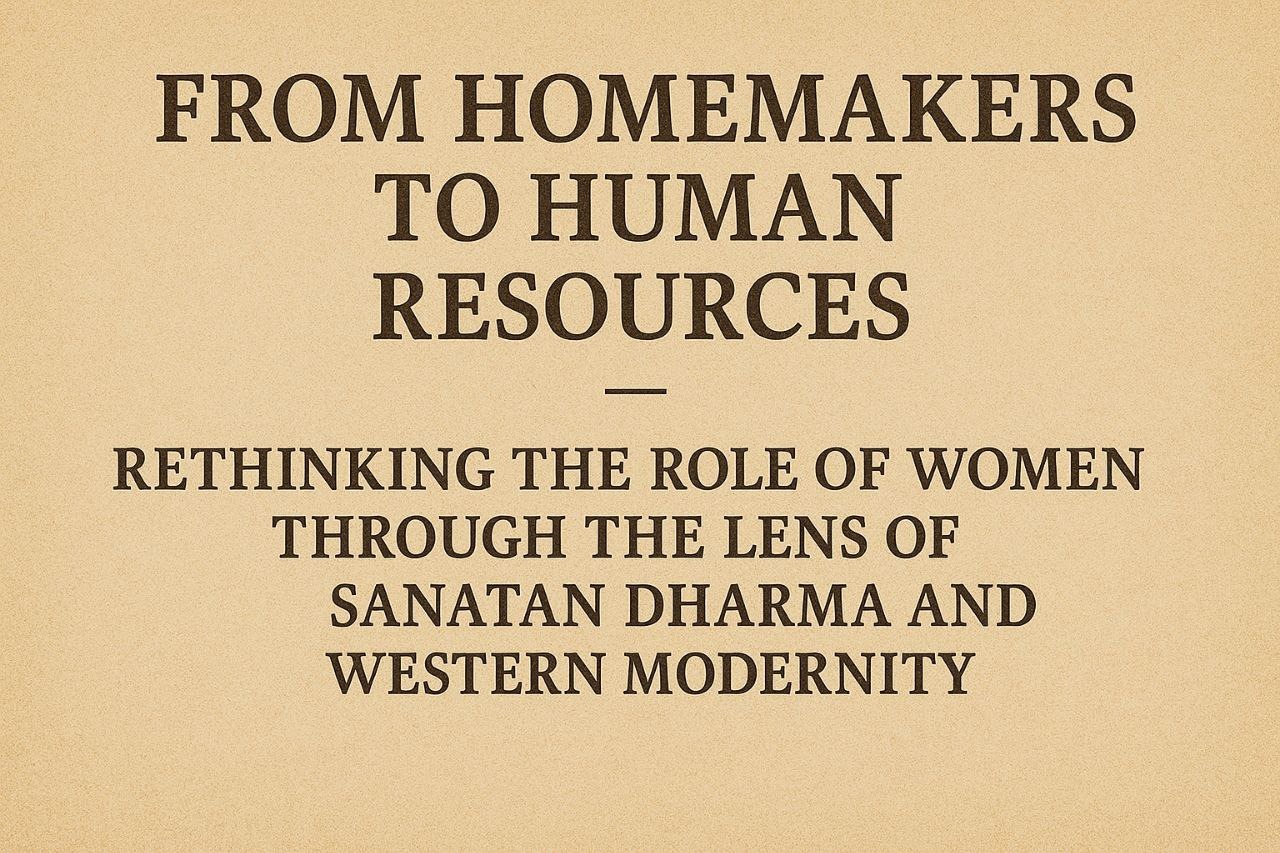From Homemakers to Human Resources: Rethinking the Role of Women Through the Lens of Sanatan Dharma and Western Modernity

In the narrative of modern civilization, particularly shaped by Western ideologies, women have often been told that their worth lies in becoming a part of the workforce, in being ‘productive’ in monetary terms. But across time and tradition, especially in the ancient civilization of Sanatan Dharma, womanhood was never measured by her salary or status. She was revered as the Shakti, the divine force behind all creation.
The Forgotten Power of the Homemaker
Once, the woman who stayed at home wasn’t called “non-working.” She was the heart of the household, the first guru of the child, the keeper of health, tradition, and emotional balance. In Bharatiya Sanskriti, she was never a secondary citizen, she was the Griha Lakshmi, the goddess who transformed a house into a sacred space.
Contrast this with Western industrial values, where labor is only recognized if it fits into a system of wages and taxation. By this metric, a woman at home, nurturing life, values, and culture, is rendered invisible. But Sanatan Dharma sees the home as the first school, and the woman as its head teacher, healer, and spiritual anchor.
Sanatan Dharma and the Sacred Feminine
In Sanatan culture, the Divine Feminine is not symbolic, she is central. Goddesses like Saraswati (wisdom), Lakshmi (prosperity), Durga (strength), and Parvati (nurturing) are not just worshipped but integrated into the daily rhythms of life. A woman isn’t encouraged to be like a man to be “equal”; she is celebrated for being a source of Shakti, spiritual, emotional, and cultural power.
In ancient India, women were scholars, saints, warriors, poets, and philosophers. From Gargi and Maitreyi of the Vedic age to queens like Rani Durgavati and Ahilyabai Holkar, Sanatan Dharma never confined women to a limited role. Her strength was not defined by rebellion but by inner realization and societal contribution, often beginning from the home.
Witch Hunts in the West: A Tale of Suppressed Wisdom
In contrast, during Europe’s Middle Ages, women who practiced herbalism, midwifery, or traditional healing were labeled “witches” and hunted down. The burning of wise women was a method to erase female-centric knowledge systems. Ironically, the same West that once killed women for brewing healing teas now markets it under “wellness industries.”
Sanatan Dharma, however, preserved such knowledge through matrilineal oral traditions, in kitchen remedies, rituals, and Ayurveda passed from mothers to daughters. But as Western models of “modernity” spread, even Indian women began to abandon this ancestral wisdom, believing it outdated.
Industrialization and the Female Workforce: A Reframed Equality
In Western economies, industrialization reduced humans to units of labor. Initially, it was men who toiled in factories, fought in wars, and suffered stress-related deaths. Then came the push to integrate women, not for empowerment, but for increasing the workforce and market consumption.
Modern feminism, especially in its Western form, declared: “Do what men do to prove your worth.” But is equality about copying roles or about valuing diversity of contribution?
Sanatan Dharma doesn’t ask a woman to mimic a man. It invites her to live from her dharma, her truth, whether as a mother, a healer, a CEO, or a saint.
Civilization Was Born from Settlement, Not Industry
When agriculture emerged, it wasn’t just crops that grew, families did. Women gained stability, respect, and centrality in households. That’s when Grihastha Ashram, the stage of life focused on family, was honored as a sacred duty. A woman wasn’t just part of the system, she was its foundation.
That’s why even today, we ask, “Are you settled?” It’s an echo of an ancient idea, that real success is anchored in inner and outer stability, not just individual mobility.
The Crisis of Modernity: Fragmented Families, Declining Birthrates
Western nations today face a demographic crisis. Japan, Italy, Germany, and even China are witnessing collapsing birth rates. Governments are offering money to couples to have children. In the name of progress, the family system was weakened, and now civilization itself is struggling to sustain.
In Sanatan Dharma, the family is the temple, and the mother is its high priestess. Raising children is not a duty, it's a sadhana, a sacred responsibility. The erosion of this value has cost the world more than we realize.
Reclaiming the Feminine Core
This isn’t about forcing women into kitchens or denying them freedom. It’s about reclaiming respect for roles that are undervalued in capitalist metrics but deeply revered in dharmic civilization.
Whether she builds empires outside or nurtures souls inside the home, a woman is never just a "human resource." She is a reservoir of rasa (essence), compassion, intuition, and inner strength.
A Return to Dharma
Western culture, in chasing freedom, often severed the roots of sacred responsibility. Sanatan Dharma, on the other hand, has always strived for balance, between work and rest, masculine and feminine, wealth and wisdom...........
The time has come to remember that progress is not in abandoning the past, but in evolving with its wisdom. When we again honor the feminine, not just in temples but in daily life, we will rediscover a civilization that is not just rich in technology, but full of grace, compassion, and true empowerment.
May we move not just toward growth, but toward balance. Not just toward freedom, but toward fulfillment. And may the divine feminine, in all her forms, once again find her rightful place at the heart of human civilization.
"True empowerment is not in mimicking the world but in remembering who we truly are, and in Sanatan Dharma, a woman has always been the sacred center of creation, not a shadow of it."
~ Adarsh Singh
Sat Apr 19, 2025
